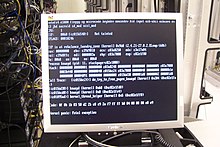



A kernel panic (sometimes abbreviated as KP[1]) is a safety measure taken by an operating system's kernel upon detecting an internal fatal error in which either it is unable to safely recover or continuing to run the system would have a higher risk of major data loss. The term is largely specific to Unix and Unix-like systems. The equivalent on Microsoft Windows operating systems is a stop error, often called a "blue screen of death".
The kernel routines that handle panics, known as panic() in AT&T-derived and BSD Unix source code, are generally designed to output an error message to the console, dump an image of kernel memory to disk for post-mortem debugging, and then either wait for the system to be manually rebooted, or initiate an automatic reboot.[2] The information provided is of a highly technical nature and aims to assist a system administrator or software developer in diagnosing the problem. Kernel panics can also be caused by errors originating outside kernel space. For example, many Unix operating systems panic if the init process, which runs in user space, terminates.[3][4]
- ^ "KP - Kernel Panic (Linux) | AcronymFinder". www.acronymfinder.com. Archived from the original on October 26, 2015. Retrieved January 6, 2016.
- ^ "FreeBSD 11.0 - man page for panic (freebsd section 9) - Unix & Linux Commands". www.unix.com. Archived from the original on April 1, 2024. Retrieved October 26, 2010.
- ^ "boot failure-init died - Unix Linux Forums - HP-UX". www.unix.com. Archived from the original on April 1, 2024. Retrieved June 12, 2013.
- ^ Randolph J. Herber (September 1, 1999). "Re: PANIC: init died". Newsgroup: comp.sys.sgi.admin. Archived from the original on January 22, 2011. Retrieved December 9, 2017.